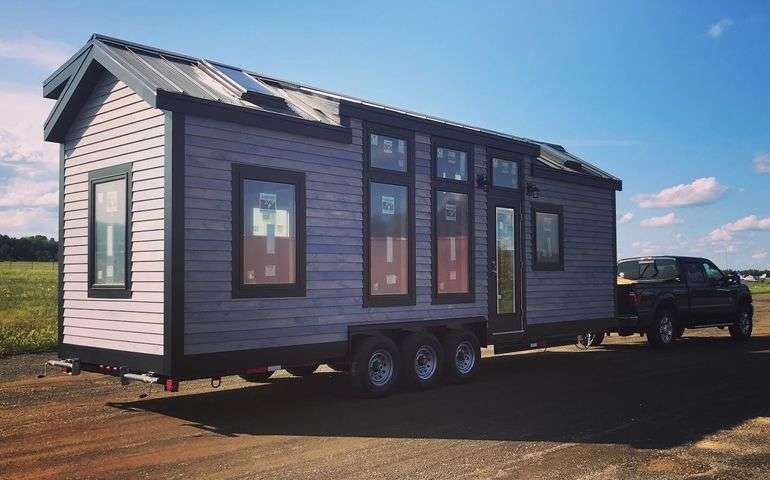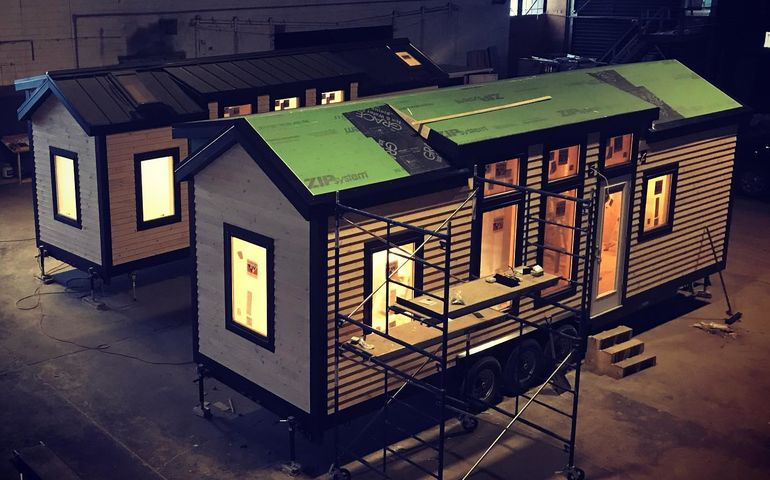
Processing Your Payment
Please do not leave this page until complete. This can take a few moments.
- News
-
Editions
View Digital Editions
Biweekly Issues
- October 20, 2025
- October 6, 2025
- September 22, 2025
- September 8, 2025
- August 25, 2025
- August 11, 2025
- + More
Special Editions
- Lists
- Viewpoints
- Our Events
- Calendar
- Biz Marketplace
Houlton’s Tiny Homes of Maine sees surge of pandemic-driven business
 COURTESY / TINY HOMES OF MAINE
Tiny Homes of Maine, a Houlton manufacturer of small, pre-fabricated houses, is seeing increased demand from a growing variety of end users due to the pandemic.
COURTESY / TINY HOMES OF MAINE
Tiny Homes of Maine, a Houlton manufacturer of small, pre-fabricated houses, is seeing increased demand from a growing variety of end users due to the pandemic.
Since the start of the pandemic, Tiny Homes of Maine in Houlton has seen a doubling in orders and a growing variety in the ways its small, customized houses are being used.
“Since March, there certainly has been a noticeable uptick in interest from people contacting us for one reason or another,” founder Corinne Watson told Mainebiz. “People are calling every day.”
The homes are under 400 square feet and sit on a steel trailer that can be moved. The most popular model, the 8-by-30-foot Allagash, sells for $76,000, but the company works with those who can't afford as much but need housing.
The company is hearing from people who are affected by the pandemic in different ways. Some, she said, are losing their home or apartment and need a place to live quickly, or their job situation is changing and they’re realizing that they can’t afford their current residence.
“We’ve had a couple of clients downsize from a 3,000 square-foot-house to 240 square feet,” she said.
Work units
Others are looking for alternative workspaces, Watson said. For example, one tiny unit is under construction as a mobile dental unit, for a Maine dentist.
“She’s making the choice to have a mobile dental unit and be out on her own,” she said. “We’ve been working with her and with a dental equipment supply company in creating a mobile unit for her.”
The company is working on a couple of mobile units for massage therapists. In one case, she explained, the customer had a home studio but is not comfortable operating inside her home during the pandemic.
“She’s getting a tiny massage therapy studio to work out of on her property, but outside of her home,” Watson said.
Other calls have come from health care workers. In one instance, she said, the company built a tiny home for a New York City nurse. The nurse has an apartment in the city, but her parents live outside New York.
“She purchased a tiny home from us to park at her parents’ property,” she said. “It’s in a rural location, so she can get away from the city and from her job for a mental recharge, but also not have to stay with her parents, because one of her parents is high-risk and she didn’t want to chance spreading anything to him. There are several stories like that one.”
Orders doubled
Before the pandemic, the company had about three orders per month and customers were mostly from central and southern Maine. Most customers were downsizing to smaller residential units as they looked toward retirement, and viewed tiny homes as an eco-friendly, inexpensive option, Watson said. Although the perception is that tiny-home users are mostly younger people, the company’s customers are mostly single woman in their 50s and 60s, she said.
Orders have doubled now. In addition to New York, inquiries and commissions are now coming from throughout New England.
“We’ve delivered to Rhode Island, Massachusetts and New Hampshire,” she said. “We just did a delivery quote for a tiny home to go to California. The delivery was close to $15,000, but they really wanted a Tiny Homes of Maine. We’re like the L.L.Bean of tiny homes.”

Many of the residential orders are from Mainers and from people trying to move back to Maine, with the idea of getting away from pandemic hotspots and working remotely, she explained. Some customers plan to park their tiny home on a friend or family member’s property. Others who don’t have prior connections in Maine are looking to purchase land.
The pandemic has caused minor problems for the business. There have been some delays in getting materials. And the company had to cancel promotional events it typically held in southern Maine where, up to now, the bulk of its customers were.
WWII hangar
Watson started the business in 2016.
Trained as an electrical engineer, she was at the time a process engineer for IDEXX Laboratories. Process engineers design, maintain and improve manufacturing processes.
“I wasn’t fulfilled doing the nine-to-five corporate gig,” she said.
The design/build work of Tiny Homes of Maine was a creative outlet, but also fulfilled a mission to provide a more-affordable housing alternative, she explained.
“Someday, I want to make it possible that everyone has a place to call home,” she said.
Her husband, Thomas Small, is a design engineer who was working for Aero Heating & Ventilating, a heating contractor in Portland. He performs the custom design work for Tiny Homes of Maine.
The two were born and raised in Smyrna, a town south of Houlton. They moved to southern Maine in 2012 for job opportunities and lived in Windham.
When Watson started Tiny Homes of Maine in 2016, she had a hard time finding employees and subcontractors in southern Maine. In 2018, she secured space in a World War II hangar at the Houlton Industrial Park, located at Houlton International Airport. She and her husband managed the business remotely for a few years. As Tiny Homes of Maine’s success unfolded, Watson left her position at IDEXX in 2018 and Small left Aero in 2019.
The pandemic drove them to seek their own residential alternative when they sold their Windham home and moved back to northern Maine.
They’re now working on expanding the company by building a new facility on a different lot in the park. The project is in the permitting phase.
“We’re hoping next year we’ll be into a new facility,” she said.
The World War II hangar “keeps us out of the elements but that’s about it,” she said. “We have heated spaces where we paint and stain, but it’s older and dusty. We can be much more efficient with a new space.”
Also, the new facility will provide a better viewing showcase for potential customers and will possibly be a site for tiny-home building workshops, she added.
Before the pandemic, the company had two full-time employees and four or five subcontractors from various trades. In the last couple of months, Watson has hired four more employees in manufacturing and sales.
“Ideally, I’d like to hire about 10 more in the next year,” she said. “We’re expanding quickly and trying to keep up.”
Mainebiz web partners
I been watching Tiny Homes for a year or more. You show great pictures of the exterior BUT I'm a woman and need to see the insides and if I can't I just move along
Tiny homes help fill a need for affordable housing, just as manufactured homes do. Potential buyers need to be aware of local zoning regulations as well as building codes. In many municipalities and states, tiny homes must have their wheels detached, and need to be secured to permanent foundations, same as manufactured homes. And some states will not license tiny homes as trailers, which make them difficult to transport.

The Giving Guide
The Giving Guide helps nonprofits have the opportunity to showcase and differentiate their organizations so that businesses better understand how they can contribute to a nonprofit’s mission and work.
Learn More
Work for ME
Work for ME is a workforce development tool to help Maine’s employers target Maine’s emerging workforce. Work for ME highlights each industry, its impact on Maine’s economy, the jobs available to entry-level workers, the training and education needed to get a career started.
Learn More
Groundbreaking Maine
Whether you’re a developer, financer, architect, or industry enthusiast, Groundbreaking Maine is crafted to be your go-to source for valuable insights in Maine’s real estate and construction community.
Learn more-
The Giving Guide
The Giving Guide helps nonprofits have the opportunity to showcase and differentiate their organizations so that businesses better understand how they can contribute to a nonprofit’s mission and work.
-
Work for ME
Work for ME is a workforce development tool to help Maine’s employers target Maine’s emerging workforce. Work for ME highlights each industry, its impact on Maine’s economy, the jobs available to entry-level workers, the training and education needed to get a career started.
-
Groundbreaking Maine
Whether you’re a developer, financer, architect, or industry enthusiast, Groundbreaking Maine is crafted to be your go-to source for valuable insights in Maine’s real estate and construction community.
ABOUT
NEW ENGLAND BUSINESS MEDIA SITES
No articles left
Get access now
In order to use this feature, we need some information from you. You can also login or register for a free account.
By clicking submit you are agreeing to our cookie usage and Privacy Policy
Already have an account? Login
Already have an account? Login
Want to create an account? Register
Get access now
In order to use this feature, we need some information from you. You can also login or register for a free account.
By clicking submit you are agreeing to our cookie usage and Privacy Policy
Already have an account? Login
Already have an account? Login
Want to create an account? Register







2 Comments